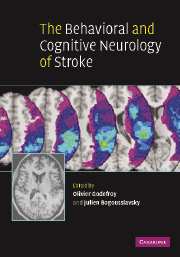Book contents
- Frontmatter
- Contents
- Contributors
- Preface
- 1 Evaluation of cognitive and behavioral disorders in the stroke unit
- Motor and gestural disorders
- Aphasia and arthric disorders
- Hemineglect, Anton–Babinski and right hemisphere syndromes
- Agnosia and Bálint's syndrome
- Executive and memory disorders
- 19 Dysexecutive syndromes
- 20 Disorders of episodic memory
- 21 Working memory dysfunctions in stroke patients
- Behavioral and mood disorders
- Dementia and anatomical left/right syndromes
- Index
- References
21 - Working memory dysfunctions in stroke patients
Published online by Cambridge University Press: 10 October 2009
- Frontmatter
- Contents
- Contributors
- Preface
- 1 Evaluation of cognitive and behavioral disorders in the stroke unit
- Motor and gestural disorders
- Aphasia and arthric disorders
- Hemineglect, Anton–Babinski and right hemisphere syndromes
- Agnosia and Bálint's syndrome
- Executive and memory disorders
- 19 Dysexecutive syndromes
- 20 Disorders of episodic memory
- 21 Working memory dysfunctions in stroke patients
- Behavioral and mood disorders
- Dementia and anatomical left/right syndromes
- Index
- References
Summary
Working memory and the Baddeley and Hitch multi-component model
Working memory refers to a system involved in the short-term maintenance and manipulation of information necessary for performing complex cognitive tasks. One of the most influential views of working memory has been put forth by Baddeley and Hitch (1974; see also Baddeley, 1986). The Baddeley and Hitch model comprises a modality-free controlling central executive that is aided by a number of subsidiary slave systems which ensure temporary maintenance of information. Two such systems have been more deeply explored: the phonological loop and the visuospatial sketchpad. The phonological loop system is specialized for processing acoustic and verbal material and is composed of two subsystems: a phonological store which can hold memory traces for a few seconds, and an articulatory rehearsal mechanism (analogous to subvocal speech) which permits memory traces to be refreshed. Neuropsychological and neuroimaging data (Baddeley, 2003) suggest that the phonological store and the articulatory rehearsal mechanism are associated with the left inferior parietal region (BA 40) and the left inferior frontal cortex (Broca's area)/premotor cortex (BA 6/44), respectively. The visuospatial sketchpad system is assumed to be involved in temporarily maintaining and manipulating visuospatial information. It may actually be composed of two distinct systems, one for maintaining visual representations, and another for spatial ones. A fractionation of the visuospatial sketchpad, analogous to that of the phonological loop, has also been proposed: a visual storage component and a more dynamic retrieval and rehearsal mechanism.
- Type
- Chapter
- Information
- The Behavioral and Cognitive Neurology of Stroke , pp. 431 - 443Publisher: Cambridge University PressPrint publication year: 2007
References
- 3
- Cited by



